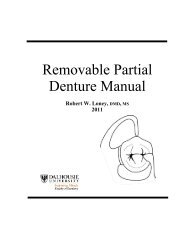Manuals_files/CD Manual 12.pdf - Removable Prosthodontics
Manuals_files/CD Manual 12.pdf - Removable Prosthodontics
Manuals_files/CD Manual 12.pdf - Removable Prosthodontics
Create successful ePaper yourself
Turn your PDF publications into a flip-book with our unique Google optimized e-Paper software.
Instructions to Patients - 4<br />
Limitations of Dentures<br />
Instructions to Patients<br />
- Dentures are less efficient than natural teeth<br />
- Some people can eat all foods easily, but these are the exception<br />
- Generally the better the ridge form, the less problems are encountered. Patients with<br />
minimal ridges should be advised that their dentures will likely move (especially the<br />
mandibular) and their efficiency will therefore be reduced<br />
- Patients with minimal ridges will likely encounter more sore spots than others<br />
- It is wise to point out these limitations to patients prior to the delivery appointment so<br />
that it is viewed as an explanation, rather than an excuse<br />
Adaptation to Dentures<br />
- Because new dentures have usually been changed in some respects to the old dentures<br />
(otherwise there would be no need for new dentures), it will take time to adapt to them<br />
- Studies show that it may take 6 to 8 weeks for patients to become optimally adapted to<br />
new prostheses (explain to patients)<br />
- Adaptability is reduced in complete denture wearers because proprioceptors of the<br />
periodontal ligament have been lost and large areas of mucosal proprioceptors are<br />
covered in acrylic<br />
- Adaptability is affected by:<br />
1. Length of time wearing dentures<br />
2. Amount of residual ridge remaining<br />
3. Degree of changes made in new dentures<br />
4. Individual variation (e.g. patients with more acute oral sensory perception<br />
have more difficulty adapting)<br />
Adaptation to Chewing may be affected if:<br />
1. CO has been changed to coincide to CR<br />
2. Tooth positions (esp. incisors) have changed<br />
3. Vertical dimension has changed<br />
These patients may experience initial decreased efficiency, cheek or lip biting.<br />
Adaptation may be improved by initially eating soft foods, increasing to hard foods,<br />
cutting food into smaller pieces, and placing food towards the corners of the mouth.<br />
Adaptation may be accompanied by an initial, transitory increase in saliva. Patients<br />
should be advised of the need to persevere while their neuromusculature adapts to the new<br />
prostheses.















